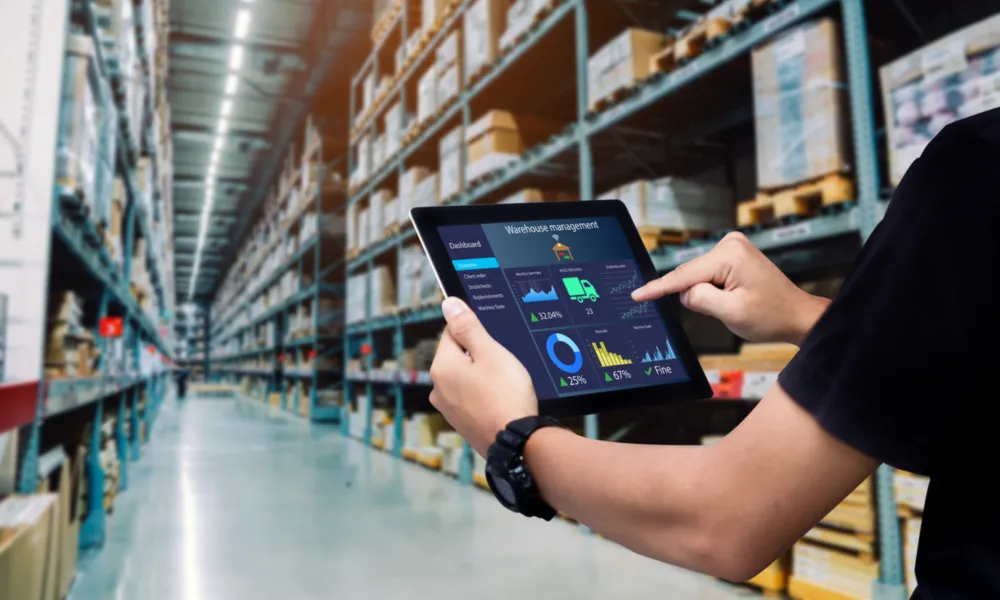
E-logistics in Vietnam is experiencing remarkable growth. It attracts substantial investment due to its unique focus on logistics services and express delivery. This trend reflects the country’s dynamic economy and adaptability to the digital age.
On the other hand, the industry is also facing challenges during its rapid development. Let’s delve into the article to learn about the obstacles, opportunities, and prospects of e-commerce in Vietnam logistics!
E-logistics, or E-Commerce logistics, defines the use of digital technologies and the internet to handle the distribution and transportation of goods. It’s not the same as traditional logistics, but these two can be combined. Due to its numerous nuances, e-logistics is an important concern for online retailers. It’s especially effective in the flow management process.

Thanks to the increased adoption of technology by logistics companies and clients, Vietnam’s e-commerce logistics business has ranked 11th among the top 50 growing markets. The industry, which already contributes 20–25% of Vietnam’s GDP, is expected to expand by 12-12% a year in the near future. Logistics firms have a chance to seize the market’s potential due to the e-commerce industry’s rapid expansion, especially in quick delivery and e-commerce-focused logistics services. Vietnam has the potential to be a successful and growing country, with several well-known corporations that have recently started investing in logistics.
Read more: How is E-Commerce Changing Logistics?
Understanding e-commerce in Vietnam logistics will provide investors with a proper background and outlook. Here are some challenges and opportunities that the market can bring:
– Infrastructure Constraints
Though e-logistics in Vietnam is anticipated to expand, sustainable growth depends on the country’s infrastructure development. Vietnam’s transportation networks are ranked 71st, with obstacles including limited infrastructure and excessive road dependence.
The government plans to construct Long Thanh International Airport and widen motorways. However, public financing for infrastructure projects is allocated slowly, and there are delays and budget overruns. Corporate investments and public-private partnerships are being considered to address these issues.
– Inefficient Operations and Management
Poor logistic provider management can result in financial losses, fraudulent activity, and a decline in the confidence of businesses and customers. It’s one of the biggest challenges for e-logistics in Vietnam.
Furthermore, a major barrier to entry for small and medium-sized logistics enterprises is the requirement for warehouses, branches, and skilled laborers in e-logistics, which necessitates new technology skills.
– Parcel Safety Issues
There’s always a possibility that parcels may be stolen or damaged in the last mile. Ensuring safe and secure product delivery is important to logistic providers, as it helps maintain client satisfaction and trust.
– High logistics costs due to limited infrastructure
Due to poor infrastructure and connections, rural regions have logistical difficulties that might result in unsuccessful deliveries. Besides the reasons for inaccurate addresses and the unavailability of the receiver, the main culprit is the difficulty reaching the locations. Meanwhile, 75% of e-commerce orders come from the major cities of Hanoi and Ho Chi Minh City, which are heavy-traffic areas. Therefore, there’s a big demand for quick and affordable delivery services.
– Last-mile delivery challenges as e-commerce continues to grow.
Since last-mile logistics directly engages clients, it is essential for e-commerce enterprises. Vietnam’s e-commerce logistics, in particular last-mile delivery companies, are still in their early stages and do not yet have the resources required to provide deliveries that are prompt, reliable, and economical. However, the rapid expansion of e-commerce in Vietnam still hints at a bright future for the industry.
– Need to use technology to improve efficiency and address cost pressures.
Large-scale international businesses are better suited for e-logistics in Vietnam, where technology is essential. Businesses need to spend millions on item sorting lines and management software to link information infrastructures to fully engage in the supply chain. However, small and medium-sized logistics companies cannot afford to invest in such infrastructure.

– Vietnam has approximately 50 enterprises providing e-logistics services.
The fast growth of Vietnam’s e-commerce industry leads to a need for an efficient logistic system. Among these 50 providers, VN Post, EMS, and Viettel Post are major players in rural regions.
However, the need for quick and easy delivery is very common among online shoppers, especially in cities. Thus, logistics start-ups have a big chance to enhance service quality and optimize operational systems.
A large number of delivery start-ups with an emphasis on e-commerce have joined the market. Some of them receive big investments and support. The most prominent ones are NinjaVan, Giao Hang Tiet Kiem (GHTK), and Giao Hang Nhanh (GHN). DHL also introduced its DHL Parcel Metro Same Day, allowing real-time tracking and delivery rescheduling. To deploy logistics services, DHL eCommerce Vietnam has teamed up with the Sendo platform, which has over 300,000 retailers.
Companies like Ahamove, LalaMove, Delivery Now, Grab, and GoViet have more prospects due to the growth of on-demand delivery, especially in the food delivery sector. The market is now more dynamic than it has ever been.
– Vietnam’s e-commerce and e-logistics growth is among the fastest and most dynamic globally.
The growth of e-commerce in Vietnam can be divided into two major phases: 2012-2017 and 2017-2021. In the first phase, the gross merchandise value (GMV) of domestic e-commerce platforms increased from $700 million in 2012 to $1.5 billion in 2017. The yearly average growth rate of e-commerce retail sales surged to 56%, from 1% to 7%.
However, phase two saw the real e-commerce growth in Vietnam, with GMV rising from $1.5 billion to $14 billion in 2021. The growth of non-COD payment options and an increase in orders from cities contributed to the market’s success. Local e-commerce platforms like Tiki and Sendo expanded, while international platforms like Lazada and Shopee started entering the market.
– Significant potential for the e-commerce logistics sector due to the fast-growing e-commerce market.
The e-commerce market in Vietnam has grown significantly, reaching $8.06 billion in 2018 and $11.8 billion in 2020. It leads to the growth of e-logistics in Vietnam. The amount of products shipped via delivery services increased by 47% in 2020, according to the Vietnam E-commerce Association (VECOM). From 2020 to 2025, the growth is predicted to maintain at a pace of 29%.
Since 86% of Vietnamese customers wish to continue purchasing online after COVID-19, there is a significant opportunity for e-logistics. Thus, the country attracts dynamic businesses and is considered among the top 8 fastest-growing logistics markets globally.

Applying smart strategies can transform and develop e-logistics in Vietnam. Some of the suggestions include:
1. Specialized Insurance Coverage
Using tailored insurance coverage, especially for last-mile logistics, will assist businesses in creating a financial safety net. It can reduce possible losses and build trust between companies and their clients.
2. Financial Protection Against Risks
Last-mile logistics can pose financial risks to businesses, such as lost or damaged items, theft during transportation, and unforeseen delays. By offering financial protection, insurance services enable businesses to face these difficulties with assurance that their assets are safe.
3. Clear and Open Claims Process
Businesses should go for insurance providers that promote efficiency and transparency by streamlining the claims process. In the event of a covered occurrence, it enables companies to easily file claims, thus, speeding up compensation.
4. Enhancing Customer Trust
Insurance solutions boost client trust in last mile delivery. They promote loyalty and confidence by making sure orders are safeguarded against any mishaps. Additionally, they give companies a competitive edge in a market where reliability and security are essential.
Free trade agreements, including the Comprehensive and Progressive Agreement for Trans-Pacific Partnership (CPTPP) and the European Union Free Trade Agreement (EVFTA), are projected to have a favorable impact on e-logistics in Vietnam. The country’s infrastructure and data system will benefit from foreign direct investment thanks to these agreements.
Plus, the government has established to lower regulatory barriers. Examples of these are Decision No. 1012/QD-TTg, which aims to create logistics centers countrywide by 2030, and Decision No. 200/QD-TTg, which aims to promote competitiveness and expand logistics services in Vietnam by 2025. New and current investors will likely spend more cash as the investment conditions improve and regulatory reform proceeds.
Since there are still some obstacles, understanding the problems of e-commerce in Vietnam logistics and coming up with affordable solutions are essential for businesses to succeed in the industry.
E-logistics in Vietnam is a rapidly growing market with a prosperous future. Its development requires proper warehouses to assist in the sorting and delivery processes.
Investing in a Vietnam warehouse promises stable and long-term profit. If you want to know more about this investing area, don’t hesitate to contact Savills Industrial for consultation.